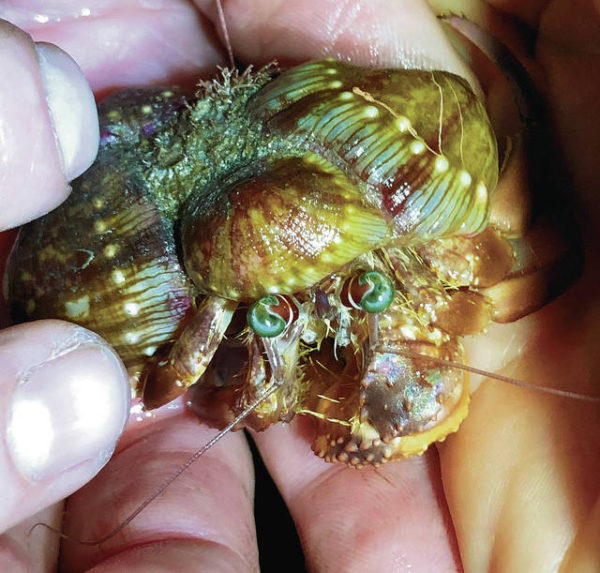Published in the Ocean Watch column, Honolulu Star-Advertiser © Susan Scott
January 12, 2019
In October I found a 1-inch-wide anemone on the broken shell of a tun snail. When I wrote that I had never seen this anemone, a species that typically rides on the back of a hermit crab shell, a friend offered to guide me to a place where the chances of finding the creatures were good. The tide, surf and weather state, however, had to be just right, as well as our availability for a nighttime excursion. Finally, conditions were right and off we went.
Two species of hermit crabs in Hawaii search out a particular kind of anemone (called Calliactis polypus, no common name), pick them up and position them on top of their shells like silly hats. The more the better. Some crabs cover the entire top and sides of their shells with the frilly anemones.
 A jeweled anemone crab.
A jeweled anemone crab.
Courtesy Craig Thomas
Of these crabs, Hawaii’s most common is the well-named jeweled anemone crab. Its eye stalks are red-and-white striped, like barber poles, tipped with roundish green eyes. Less common is a cream-colored individual called the pale anemone crab.
Hermit crabs have long, curved tails that they coil deep into empty snail shells, the crabs using several of their rear legs to hang on. In this, size matters a lot. The shell can’t be too large because the crab has to haul it around to forage for food. Nor can it be too small, or the crab can’t retreat inside and protect itself from predators.
Hermits never kill a snail to get its shell, but as the crab grows it must search for a larger home. If it finds a shell occupied by another hermit crab, a fight might ensue.
The shells of anemone crabs can be regular boardinghouses for other marine animals. Besides the outer shell being covered with anemones, smaller white anemones often line the edge of the shell above the crab’s head. A flatworm, a tiny shrimplike animal called an amphipod and a stalked barnacle also might share this crab’s shell.
In these relationships, the hitchhikers get rides and scraps, and the crabs get protection, at least from the anemones, which bear stinging tentacles.
Anemone crabs can be found in tidal pools to 100 feet deep. During the day the 2-inch-wide crabs rest in hiding. At night the scavengers come out to search for food, eating anything they find, plant or animals, dead or alive.
For our anemone crab search, we set out after dark with headlamps and flashlights, searching tide pools for the crabs my friend had seen there in the past. An hour later, just when I was about to give up, there they were: several crabs so covered with anemones it was hard to tell they were crabs at all.
I’ve never been fond of nighttime ocean excursions because it’s cold, I’m sleepy after dinner and the view, whether tide-pooling, snorkeling or diving, is limited to a single beam of light.
Seeing those adorable crabs in their fancy outfits, however, was well worth the effort. Thank you, Alan.